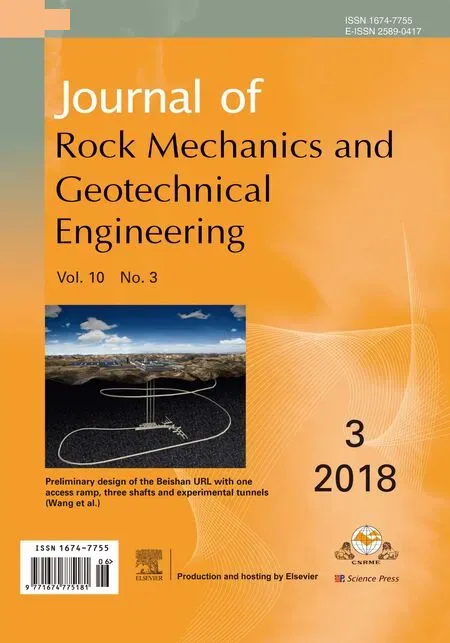Corrigendum to“Numerical interpretation of transient permeability test in tight rock”[J Rock Mech Geotech Eng 1(2018)32-41]
2018-02-14ChongCao
Chong Cao
Formerly,Department of Civil Engineering and Applied Mechanics,McGill University,817 Sherbrooke Street West,Montréal,QC,H3A 0C3,Canada
It has been drawn to the author’s attention by an internationally highly-acclaimed expert(reader)that several important articles that have a bearing on the results presented in this paper,particularly with regard to the influence of the air fraction in the pressurized cavity on the interpretation of the hydraulic pulse test performance,have previously been published:
Głowacki A.Stress-induced permeability evolution in limestone rocks.PhD Thesis.Montréal,QC,Canada:McGill University,2017.
Najari M.Acomputational and experimental modelling of thermo-hydro-mechanical processes in a low permeability granite.PhD Thesis.Montréal,QC,Canada:McGill University,2013.
Najari M,Selvadurai APS.Thermo-hydro-mechanical response of granite to temperature changes.Environmental Earth Sciences 2014;72(1):189-198.
Selvadurai APS,Głowacki A.Stress-induced permeability alterations in an argillaceous limestone.Rock Mechanics and Rock Engineering 2017;50(5):1079-1096.
Selvadurai APS,Ichikawa Y.Some aspects of air-entrainment on the decay rates in hydraulic pulse tests.Engineering Geology 2013;165(15):38-45.
Selvadurai APS,Najari M.On the interpretation of hydraulic pulse tests on rock specimens.Advances in Water Resources 2013;53(1):139-149.
Selvadurai APS,Najari M.Laboratory-scale hydraulic pulse testing:influence of air fraction in cavity on estimation of permeability.Géotechnique 2015;65(2):126-134.
Selvadurai APS,Najari M.Isothermal permeability of the argillaceous cobourg limestone.Oil&Gas Science and Technology 2016;71(4):53.
The author regrets missing these relevant references,which should have been added to the paper for a better comparison of the experimental results and numerical simulation.The research work presented in this paper was completed at McGill’s Environmental Geomechanics Laboratory in 2015.The author wants to express his sincere gratitude to Professor A.P.S.Selvadurai for his supervision and support through the author’s doctoral research.The author decided to withdraw from the PhD program in the fall of 2016 and left McGill University in February 2017 after obtaining his MEng Degree.Therefore,the author would also like to make a correction to his biography,which may potentiallygive the incorrect impression that he was still a doctoral student at McGill University at the time of submission of this article to Journal of Rock Mechanics and Geotechnical Engineering(JRMGE).
The author wishes to acknowledge Professor Songqing Lin,Vice Dean of Editorial Of fi ce of JRMGE,for his assistance and guidance in this matter and for facilitating this Corrigendum.
杂志排行
Journal of Rock Mechanics and Geotechnical Engineering的其它文章
- Reply to Discussion on“Empirical methods for determining shaft bearing capacity of semi-deep foundations socketed in rocks”
- Discussion on“Empirical methods for determining shaft bearing capacity of semi-deep foundations socketed in rocks”[J Rock Mech Geotech Eng 6(2017)1140-151]
- Correlations between ultrasonic pulse wave velocities and rock properties of quartz-mica schist
- Assessment of clay stiffness and strength parameters using index properties
- Numerical simulation of the behaviors of test square for prehistoric earthen sites during archaeological excavation
- Optimization of dewatering schemes for a deep foundation pit near the Yangtze River,China
